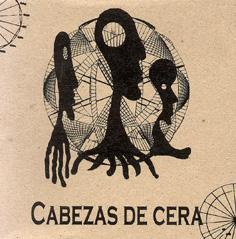Quantum Fantay & Cabezas de Cera welcome Prog to the 21st Century at Nearfest 2009
 For some reason, the opening acts on Saturday & Sunday’s Nearfest always provide the most exciting, unexpected moments – think Morglbl, Indukti, KBB and Guapo from recent years – and that was certainly the case with Quantum Fantay and Cabezas de Cera. Hailing from Belgium and Mexico respectively, each group proved the universal appeal of prog, while bringing something decidedly new to the table.
For some reason, the opening acts on Saturday & Sunday’s Nearfest always provide the most exciting, unexpected moments – think Morglbl, Indukti, KBB and Guapo from recent years – and that was certainly the case with Quantum Fantay and Cabezas de Cera. Hailing from Belgium and Mexico respectively, each group proved the universal appeal of prog, while bringing something decidedly new to the table.
Of all the bands at Nearfest this year, Cabezas de Cera was the one that actually seemed like a 21st century ensemble. They certainly had the most unique instrumental line-up at the festival. In fact, guitarist Mauricio Sotelo alone had more unusual instruments than the last 5 Nearfest’s combined. He played the charrofono, which sounded like an Indian sitar and had a huge gourd at one end, the armatoste, which looked like a space-lute with it’s half-moon body and sounded like a Turkish saz or oud, Jarana Prisma, which looked like a 12-string guitar from the back of the hall but was actually a 12-string harp, and then normal instruments like the Chapman Stick. Mauricio’s brother, Francisco Sotelo played a hybrid drum set with acoustic drums, kalimba and electronic pads. Ramsés Luna besides playing saxophones also employed an electronic wind controller, and played it better than anyone I’ve heard. He used it for decidely non-saxophone sounds, but got the kind of of squeels and overblowing that you’d expect form a free jazz player.
 Collectively the band navigated tightly constructed compositions that unfolded into free improvisations and back. A power trio track might lead into a sweet soprano saxophone interlude. Mauricio dialed up loops to create modal cycles and the band blew through them in metal-edged interplay. On “Pretexto a un TextoFragmentado,” Ramsés did a Mexican speed rap like a crazed megaphone toting street politician meeting a whacked out DJ. At any minute I expected him to break out in English: Sunday, SUNDAY, at New England Dragway, Johnny Taylor and his hemi-overdive funny car, Sunday, SUNDAY.” (You have to be a certain age to get that reference).
Collectively the band navigated tightly constructed compositions that unfolded into free improvisations and back. A power trio track might lead into a sweet soprano saxophone interlude. Mauricio dialed up loops to create modal cycles and the band blew through them in metal-edged interplay. On “Pretexto a un TextoFragmentado,” Ramsés did a Mexican speed rap like a crazed megaphone toting street politician meeting a whacked out DJ. At any minute I expected him to break out in English: Sunday, SUNDAY, at New England Dragway, Johnny Taylor and his hemi-overdive funny car, Sunday, SUNDAY.” (You have to be a certain age to get that reference).
Some of their free-flowing soundscapes recalled the spontaneous interplay of Weather Report in their Body Electric days, but with a distinctive, Latin edge, especially when Mauricio played the 12-string harp. And like Weather Report back then, they weren’t afraid to engage in pure sound exploration. Mauricio Sotelo picked up an instrument that looked like a small bent I-Beam with strings suspended in the middle, like an industrial berimbau. He bowed it and beat it into a dissonant wail while Francisco created a storm of percussion behind him.
 Quantum Fantay led off Sundays round and established a standard that wasn’t quite met until PFM‘s headlining performance. Coming out of Belgium, this quintet found a meeting ground between Ozric Tentacles style space rock and fusion, although the Ozric connection might be a bit overstated. They use synthesizer sequencers to underpin some of their music, but their sound leans more towards fusion in its rhythms and structural shifts, but without the improvisation.
Quantum Fantay led off Sundays round and established a standard that wasn’t quite met until PFM‘s headlining performance. Coming out of Belgium, this quintet found a meeting ground between Ozric Tentacles style space rock and fusion, although the Ozric connection might be a bit overstated. They use synthesizer sequencers to underpin some of their music, but their sound leans more towards fusion in its rhythms and structural shifts, but without the improvisation.
Their use of flute, often harmonized, gave their hard-driving sound a bit of airiness that other bands lack. From the opening piece, “The Spirit” off their Kaleidothrope album, they established a different sound from the guitar-keyboards driven approach of every other Nearfest band but Cabeza de Cera. Karel Slabbaert‘s harmonized flutes were like a search light arcing across a furious groove and his interplay with Glenn (Dario Frodo) Ployaert‘s heroic guitar leads always took things to a higher level. Like Cabeza De Cera, though not as extreme, the group had a few other timbral differences from other Nearfest bands. Tablas emerged on one track and on “Cube” they used tuned (sampled) percussion and a reggae interlude (where were the Prog Police). Quantum Fantay never let up and every song was like a charge for the heavens. The name, by the way, is an unintentional typo on “fantasy” that they decided to embrace. Or as Brian Eno might say, “Honor thy error as a hidden intention.”
I’ll wrap up the rest of the festival, finally, and belatedly, soon.
John Diliberto ((( echoes )))
